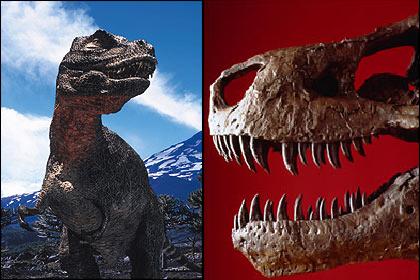Tyrannosaurus rex reached its massive size due to enormous growth during its childhood

American researchers claim that the growth of the meat-eating dinosaur was manifested in an increase in weight at a monstrous rate. Up to 2 kg per day for more than 4 years!
The group examined the bones of about 20 tyrannosaurs (the group of dinosaurs to which the T. rex belongs) to determine their growth rate. Details of the study were published in the scientific magazine Nature.
Gregory M. Erickson from the University of Florida and his colleagues followed growth lines in the bones to estimate the age of the dinosaurs. The researchers measured the circumference of the bones and created a growth curve for the dinosaurs.
The findings showed that dinosaur T. Rex had a maximum weight gain of about 2.1 kg per day between the ages of 18-14. After 2 decades the dinosaur reached maturity and its growth stopped.
In total, during this period, the dinosaur increased its weight by about 3 tons.
Tyrannosaurus Rex weighed around 5000 kg and lived up to 28 years.
Until now, two theories have been proposed to explain the huge size of the Het. Rex. The first Shaht. rex did grow at a faster rate than its tyrannosaur relatives or it grew over a longer period of time.
In addition to Tyrannosaurus rex, the researchers also examined bones of 3 other species of dinosaurs: Albertosaurus sarcophagus, Gorgosaurus libertus and Desplatosaurus toruseus.
The researchers found that these species had a maximum growth of only about 300 to 500 grams per day.
As for their relative Het. rex, these species also maintained a similar growth rate for about 4 years, but because they gained weight at a much lower rate, they did not reach the size of the t. rex which was much larger than all members of the tyrannosaur family.
Two kilograms a day for four years
The Tyrannosaurus rex reached its gigantic dimensions thanks to a growth spurt during adolescence
Tyrannosaurus rex, as any five-year-old knows, was enormous - the most threatening predator of the age of dinosaurs. But no child or scientist was able to find out how these creatures reached such large dimensions.
They may have gone through a huge growth spurt in their youth. Or continued to grow for many years, more than other dinosaurs. Paleontologists now believe the answer has been found: a growth spurt during puberty, during which T. rex gained, on average, two kilograms per day for four years.
According to a new study on Tyrannosaurus bones, which was published last week, the T-Rex gained about 14 kilograms from the age of 18 to the age of 3,000, until it reached its full adult weight - more than 5,000 kg, with a length of about 13 meters and a height of about four meters from the foot to the the thigh. "One can stop guessing how T-Rex and some of its relatives grew to gigantic dimensions," said Dr. Peter McCowicki of the Field Museum in Chicago in a telephone interview.
Makowicki was a member of the team of paleontologists who conducted the study on 20 fossil specimens of four very closely related Tyrannosaurus species. They used a modern method for age estimation - counting the growth rings in the bones - and accordingly calculated the body size based on measurements of the circumferences of the leg bones. Their conclusion is that "the huge size of the T-Rex was achieved mainly thanks to the acceleration of the growth rate beyond that of the species closest to it".
Dr. Paul Cerno of the University of Chicago, a paleontologist who was not involved in the research, said the findings are "very credible" and are an important step forward in understanding the tyrannosaurs, which lived more than 65 million years ago. "They did something very different and a little more efficient to grow so fast and to such dimensions," Serano said.
One of the surprises, he added, is the researchers' assessment that the T-Rex probably did not live for more than 30 years. One of the fossils in the study, a tyrannosaurus known as Sue at the Field Museum, died at the age of 28 and the chassis showed signs of wear due to old age. "It seems like a waste, to get to that size and then go away so quickly," Serano said.
According to the researchers, "The presence of narrow, compressed growth rings late in development shows that the growth of these animals, like that of most (if not all) dinosaurs, had definite limits. They would not have reached significantly larger dimensions than the largest fossils examined in this study, and they might have spent close to 30% of their lives as adults who reached their peak size."
It has long been known that large dinosaur bones show growth rings, similar to the growth rings of trees. But these rings are damaged and flimsy, because the bones lose mass and become hollow over time. The head of the team of researchers, Dr. Gregory Erickson of Florida State University, explained that the study was done instead on smaller bones, such as ribs and tibia. These bones do not develop hollow foramina and do not change over time, and therefore preserve a more complete record of the dinosaur's growth.
The researchers used a diamond saw to cut thin slices of the bone, which were then examined under a polarizing microscope. T-Rex bones that were between 28 and XNUMX years old were compared to bones from three related species. "T-rex was very different," said Makovicky, "its growth rate was four and five times greater than that of the other tyrannosaurs."
For news at the BBC
